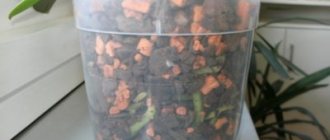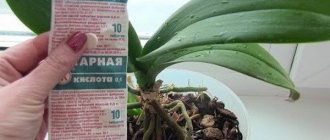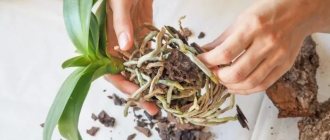Fusarium
A common infectious plant disease, quite dangerous.
With fusarium, orchid tissue and the vascular system are affected. This disease begins with the root system, and then the pathogens, entering the plant, rise up through the conducting vessels. The mycelium, growing, reaches the lower leaves along the stem and rises higher.
Attention! Fusarium is very tenacious. If 70% of the mycelium died during treatment, then the remaining 30%, once in an unfavorable environment, freeze until the next awakening.
Infection can also occur through mechanically damaged areas (breaks, punctures).
How to cope with fusarium? Description of the disease, photo of the affected orchid and treatment tips
The natural habitats of orchids are tropical forests with dense dense foliage. Once in our apartments, it is difficult for a tropical beauty to adapt and change its natural habits. Because of this, orchids are considered one of the most capricious house flowers, the care for which is specific. They are more susceptible to various diseases than other indoor plants.
There are 3 main types of diseases to which orchids are prone. These are fungal, bacterial and viral. Fusarium is a fungal disease. Its treatment will be effective only in the early stages, before damage to the root system begins.
Fusarium is an infection of a plant by Fusarium fungi . Fungi reproduce through spores (conidia). The disease belongs to the group of infectious and very dangerous diseases. The pathogen enters the plant through microcracks, the area near the stem, rhizome, or through seeds and seedlings infected with spores. There are 2 types of fusarium rot: root and stem.
Check out the photo below of an orchid infected with fusarium:
What does it look like?
- Root . When root infection begins, it turns red, and as fusarium disease progresses, depressed spots appear on it (reminiscent of traces from a tight bandage). Over time, the reddened areas of the root darken and die.
- Leaves . They turn yellow and curl. The disease develops from the top of the plant and spreads throughout the flower.
- Stem . It acquires a dark brown color, loses elasticity, and becomes thin.
- Places of cuts . Dark brown rings are clearly visible on the walls of the vessels.
Signs of fusarium in orchids
When orchids are infected with fusarium blight, the leaf turgor first disappears.
The mycelium, growing, clogs all the vessels and poisons the plant with the toxins released from it. This is clearly visible on the cut of the stem.
Soon spots appear, they are different in shape, at first they have a yellowish tint, then they darken, and a black edge appears on them.
The area of the depressions gradually increases, the affected tissue becomes thinner, and rot appears.
The leaves begin to yellow and fall off. Flowering stops. This is a very common disease on phalaenopsis.
Fusarium wilts are very dangerous for any indoor crops. Both regular and exhibition specimens are susceptible to the disease. The variety also does not matter; in case of infection, no one can resist fusarium.
Prevention
To avoid Fusarium infection, follow these recommendations:
- ventilate the room and loosen the soil;
- do not allow the temperature to drop below -15 degrees;
- disinfect the soil before planting;
- observe the norm of peat and polystyrene in the soil - no more than 1/5 of the total mass;
- observe the watering regime - avoid frequent wetting;
- replant the orchid every 6 months;
- choose only special fertilizer complexes for orchids;
- place the flowerpot in a bright place, but avoid direct sunlight;
- Regularly inspect the crop for infestations and pests.
An orchid is a very capricious plant that requires constant care. Otherwise, the culture begins to hurt. But if you provide the flower with optimal development conditions, it will delight you with its lush blooms for a long time.
Causes of infection
If a favorable environment appears, the fungi awaken and begin active life.
The source of infection can be:
- prolonged low substrate temperature;
- soil is too wet;
- stagnant air, lack of circulation;
- spread from a diseased plant brought from outside.
Fungal spores very quickly colonize new territories if the environment is favorable for them and if the orchids are weakened.
If the disease has captured most of the plant, then its death is inevitable.
The conclusion is not complicated - the activation of the fungus is facilitated by prolonged discomfort for the plant: sudden changes in temperature, lack of lighting, combined with excess moisture in the substrate.
Causes of fusarium rot
The most favorable conditions for the development of fusarium:
- excessive amounts of nitrogen;
- low ground temperatures;
- mechanical damage to the root system during transplantation;
- waterlogging, excessive watering;
- a large amount of peat in the soil;
- lack or complete absence of microorganisms in the substrate that are responsible for increasing the immunity of the orchid;
- poor air circulation in the room or its complete absence;
- increased salt content in the soil.
You can learn more about the causes of black rot and other rot on orchids here.
Treatment of infected orchids
Most often, the appearance of fusarium is not given any importance. Understanding the seriousness of the situation comes too late.
First of all, it is important to isolate the plant infected with Fusarium. Immediately carry out preventive treatment of the remaining and still healthy plants. Biological preparations such as:
- Baktofit;
- Fitosporin – M;
- Vitaros.
Next, you need to inspect the entire plant. To do this, it must be pulled out of the pot and freed from the substrate.
If there are damaged roots, they are cut off to healthy tissue. The cut areas are disinfected with cinnamon, activated carbon powder, and hydrogen peroxide has also worked well.
The plant is washed and treated with one of the methods suggested below. The choice depends on the degree of damage to the orchid. After all, with severe infection, folk remedies are unlikely to help.
The flower, treated with the necessary preparations, is placed in a quarantine zone for several weeks.
Folk remedies
If you are lucky, the disease is detected at the initial stage of infection, then folk remedies are quite suitable, such as:
- treatment with infusion of ash (1 tablespoon of ash per 1 liter of boiling water, leave for 48 hours);
- treatment with tagetis infusion (dried flowers are brewed and sprayed).
Having not received the proper results after 3 days, they move on to the next stage of treating orchids for fusarium.
Chemicals
Use fungicides strictly according to the instructions and in compliance with all precautions.
The most common means of combating fusarium on orchids is Fundazol. Only 1 g of active ingredient per 1 liter of water. The treatment is repeated after 10 days. Benomil, Vitaros, Oxychom, Maxim and others are also recommended. The choice is great.
Biological
Antifungal biological drugs - Fitosporin, Fitocid, Trichodermin can be used as prophylactic agents.
It is also recommended to use Trichofit, Glyokladin, Previkur.
The basis of the drugs are antagonistic mushrooms.
Hydroponics and fusarium
There are times when an orchid grows, for one reason or another, without a substrate, in water. The question arises whether hydroponics can stop fusarium. Unfortunately it can't. Fungal spores and the mushrooms themselves thrive in a humid environment - they are anaerobic (can live without oxygen).
However, when infected with Fusarium in hydroponic cultivation, it is easier to replace the substrate (aqueous solution).
What is the danger?
The mycelium of fusarium fungi clog the plant's vessels, thereby disrupting their conductivity and depriving the orchid of water and mineral salts. Parts of the flower to which access to moisture is blocked darken, become covered with dents, and wilt is observed. If only the aerial part is affected by the fungus, then there is a chance for successful treatment. When the root system is infected, the death of the orchid is inevitable.
Phalaenopsis infected with fusarium becomes a source of danger for its neighbors on the windowsill. The spores of the pathogen are easily spread by air.
Preventive measures
Knowing that the development of the disease is facilitated by the weakened health of orchids and high humidity, a number of measures are observed, namely:
- Mandatory quarantine for a new copy.
- Regular ventilation of the room with orchids.
- Maintaining distance between pots. Control of humidity levels, both air and soil.
- Sterilize all working tools with alcohol.
- Treating the soil with copper sulfate. Calcination or freezing.
- Regular cleaning and disinfection.
- Timely removal of affected plants.
What is fusarium rot?
As a rule, orchids are affected by 3 types of diseases, provoked by the following pathogens:
- Fungal infections are the most numerous by type, appear on the leaves in the form of plaques and dark brown putrefactive spots, develop quickly and lead to the destruction of flowers (read about what causes orchid leaves to rot and what to do about it here).
- Bacterial lesions often cause rotting of the rhizomes, gradually spreading to the entire plant; the leaves of the plant change color from green to dark yellow, becoming covered with spots and ulcerations.
- Viral diseases , in which the leaves become covered with spots in the form of mosaic patterns of a round or dashed shape. This form of damage is considered incurable.
The causes of orchid disease are different - lack of sunlight, excess or lack of humidity, overheating or hypothermia.
As noted above, the most common are fungal infections of flowers. And among fungi, fusarium orchid blight is the most common.
Fusarium is infection of a plant by fungi of the genus Fusarium . It is considered an infectious and quite contagious disease. The fungus enters the flower through the rhizome or near-root zone of the stem, as well as through seeds or seedlings infected with fungal spores.
At the first appearance of white-pink dust particles in the form of tiny balls on the stems and root areas, it is necessary to separate the plant from other flowers and begin immediate treatment. Fungal diseases of indoor pets are curable only in the early stages, before the roots are affected .
Check out the photo of fusarium in orchids:
External signs of fungal infection
External signs of the disease will help distinguish fusarium from other ailments. The infection process can be very long and last from six months to one and a half years. The disease has several stages:
- First, infection occurs with fungal spores and it is difficult to understand from external signs that the orchid is infected.
- Some areas of the root system acquire a pinkish color, which will later turn purple. It is in the rhizome that the disease originates.
- Later, you may notice small indentations, as if the root system is damaged.
- Rotting begins and the root turns brown.
- Then the disease moves to the trunk, leaves and petals.
When the root is affected by spores, the release of toxins begins. They block the flow of moisture and the plant dies. When the leaves begin to turn yellow and the flowers fade, it will be very difficult to save the orchid. It is necessary to resort to preparations with a chemical or biological composition, and to nurse the flower for a long time.











